There are hundreds of varieties of Chillies growing all over India. Adding them to curries, stews, and dry vegetables is essential to Indian cuisine. Chillies can be eaten raw or cooked. Sun-dried Chillies, which turn red when dried, is then ground into a powder and used in Indian cuisine as a spice. “Capsaicin,” an alkaloid contained in Chillies, is responsible for their spice. Indian cuisine was only spiced with black pepper before Vasco-Da-Gama introduced Chilli in the 16th Century.
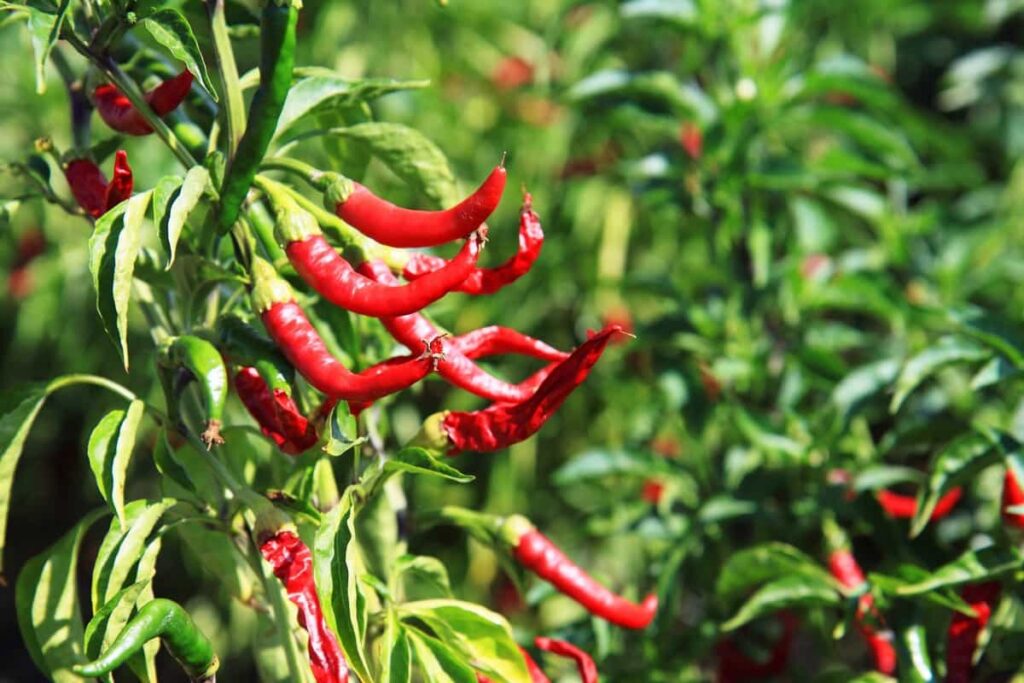
Rainfed Chilli crops are transplanted mainly in June-July, and Chilli crops transplanted early in June in the Dharwad region be resistant to thrips and mites. However, late-planted or late-variety crops are less likely to suffer from anthracnose fruit rot because they ripen after the Sept-Oct rains. The best yields are obtained around Bangalore with transplanted crops planted in July. A Chilli crop is extensively grown in India between June and October for ripe, dry fruits; however, a Chilli crop is grown year-round for green fruits.
High yield Chilli varieties
Even though Chillies are not native to India, it is the biggest producer and exporter of raw & dried Chillies, and Chilli powder today. The Indian Chilli industry contributes 25% of the world’s total Chilli production. Andhra Pradesh is India’s largest Chilli producer, followed by Maharashtra, Karnataka, Gujarat, and Tamil Nadu. It is now possible to cultivate large quantities of hybrid Chilli on a large scale for commercial purposes due to the introduction of a wide variety of hybrid varieties. The following are the most common hybrid Chilli varieties in India.
High Yield Hybrid Chilli varieties in India
Punjab Sindhuri
The plants are dark green, compact, and medium in height. The first picking of red fruits (75 days after transplanting) is possible with this variety as it matures early. When immature, the fruits are dark green; when mature, they are deep red. 17 to 19 tons of red ripe fruits are produced in an average hectare.
In case you missed it: How to Grow Green Chilli Peppers Faster: Best Tips to Increase Flowering, Fruiting, and Production Yield
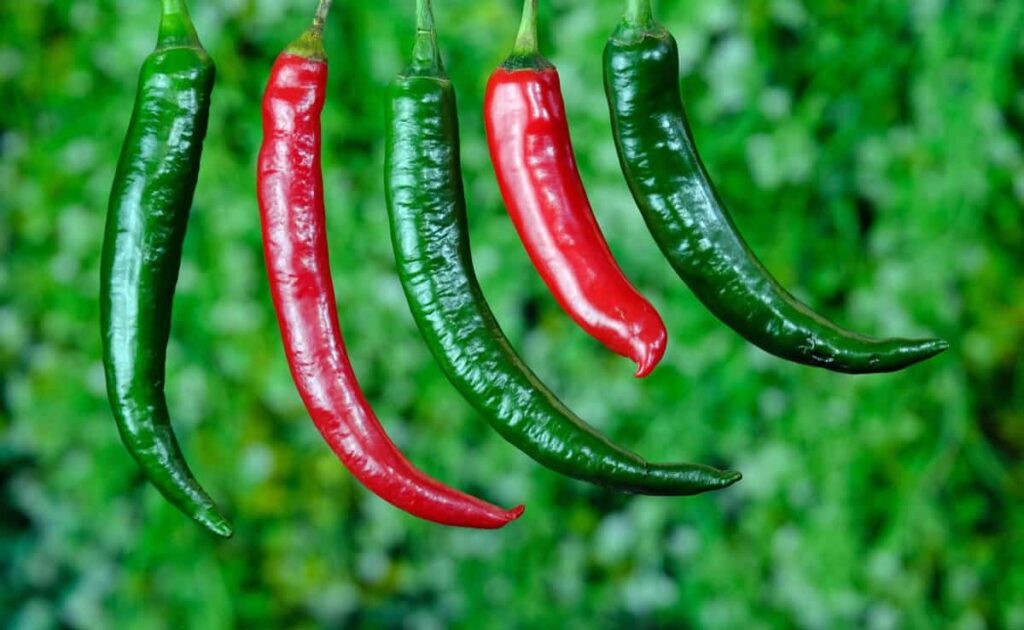
Punjab Tej
They are medium tall, light green, and spread widely. This variety matures early; the first crop (red fruits) is available 75 days after transplanting. The fruits are long (6.80cm), thin-skinned, light green when immature, and deep red when mature. On average, 14 tons of red ripe fruits are produced per hectare.
Punjab Surkh
This variety has dark green leaves with long fruits of 7 cm in length. Immature fruits are green, but mature fruits are dark red. It is used for making salads and for drying. The fruit is resistant to fruit rot and mosaic virus. On average, it yields 20 tons per hectare.
CH-27
The plants are tall and continue to bear fruits for a long time. When mature, the fruits are deep red, medium long, thin-skinned, light green when immature, and light green when immature. Root-knot nematodes and leaf curl virus are resistant to it, and sucking pests such as mites are not an issue. In an average hectare, 23 tons of ripe red fruits are produced.
5o-1
TNAU developed this Chilli variety from a Sathur Samba type. A hectare of this plant yields 2.1 tons of dry Chilli in 210 days. Its plants are erect, medium, tall, and compact, and its fruits measure 7.3 cm long with a capsicin content of 0.72 mg per gram.
Co-3
TNAU, Coimbatore, released it. It is a selection from Sri Lanka’s introduction. It is a dwarf-less spreading plant. It is suitable for very close planting. A hectare of this crop yields about 15 to 18 tonnes of green pods or 3.5 tonnes of dry pods.
PMK 1
At TNAU, Coimbatore, it was developed. It is a cross between CO2 and Ramanathapuram gundu. It yields about 2.3 tons of dry Chilli per hectare when grown in rainfed conditions. Per gram, capsaicin content is 0.36 mg.
G-4 (Bagyalaxmi)
The high-yielding potential of this variety makes it a popular choice among growers. Approximately 8.8 cm long fruits grow on tall, dense plants. The fruits are bright red and contain 0.52 mg of capsaicin per gram. Dieback, anthracnose, and murda diseases are not a problem for this variety. Under rainfed conditions, this variety yields 1.1 tons per hectare, whereas, under irrigation, it yields 5 tons per hectare.
G-5 (Andra Jyothi)
In this variety, G-2 crosses with the Bihar variety (1331), a thrips-tolerant variety. Plants are tall and dense, with red fruits measuring 5.1 cm in length and 6.3 cm in circumference. Each gram of fruit contains 0.65 mg of capsaicin. The yield per hectare is 1.7 tons.
In case you missed it: Best Practices to Grow Green Chilli (Mirchi): The Best Guide for Beginners
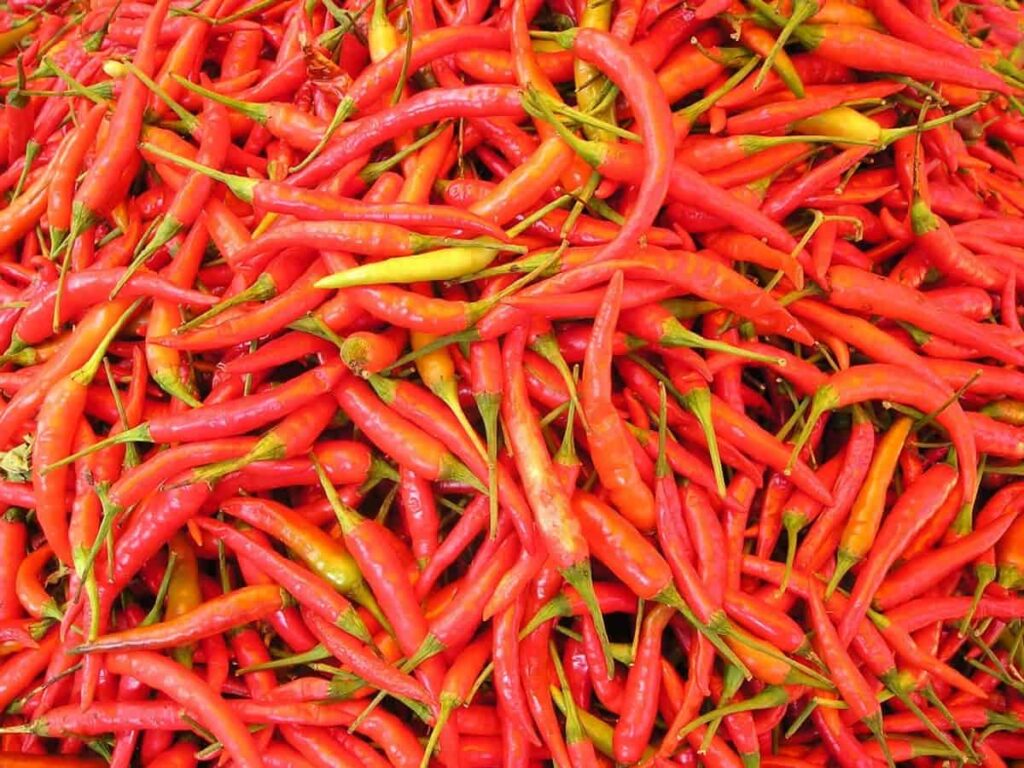
NP 46A
Indian Agricultural Research Institute developed this variety. The plants are dwarf, dense, and spreading. There are fewer seeds in this cultivar, and it contains 0.53 mg of capsaicin per gram of fruit.
Pusa Jwala
It was released at IARI, New Delhi. This variety is a cross between NP 46A and puri red. The plants have a dwarf habit and are spreading. Long red fruits contain 0.48 mg of capsaicin per gram. The fruit is 9 to 10 cm long, light green, highly intense, and resistant to thrips and mites. On average, the yield per hectare (dry) is 1.8 tons, and the yield per hectare (green) is 8.4 tons. Between September and December, they are harvested.
Pant C-2
A cross involving the same parents as Pant C-1 plants yields about 1.4 tons of dry Chillies per hectare and is tolerant to leaf curl and mosaic.
Sindhur
The sample was selected from CA960. Fruits have a thick pericarp that is deep red. A gram of fruit contains 0.81 mg of capsaicin and measures 8.2 cm in length.
JCA154
JNKV Madhya Pradesh developed this pickling cultivar. A ripe fruit is bright red, while an unripe fruit is dark green. The fruits mature between 115 and 120 days after being planted.
Pusa Sadabahar
This Chilli cultivar is multipurpose. Besides being consumed green, it can also make red powder and oleoresin. Fruits are produced in clusters of six to fourteen to facilitate bunch harvesting. The hybrid was developed by crossing Pusa jwala x IC 31339 (C.Frutescense). Fresh fruit yields 7.5 to 10 tons per hectare, while red-dried fruit yields 1.5 to 2 tons per hectare.
X-235
It is a cross between G4 and Anther mutants. Spreading plant with short internodes at the beginning of its maturity. The leaves are small and dark green. Flowers with yellow anthers as markers. The fruit is 5 to 6 cm long and has a pointed tip.
Arka Lohit
IIHR, Bangalore, released it. It is a selection from IHR 324, and the plants are tall and spread with light green foliage. Suitable for rainfed conditions due to its tolerance to moisture stress. With a capsaicin content of 0.21 percent, its fruits are dark green and have a high yield potential of 3.5 tons per hectare of dry or 20 to 25 tons per hectare of green Chillies.
Arka Harita
A high-yielding Chilli F1 hybrid developed from an MS line. The plants grow to about 1m tall and spread to about 90 cm wide. Medium-sized fruits reach a length of 10 cm and a width of 1 cm. Fresh yields can reach 31 tons per hectare, and dry yields can reach 6 tons per hectare within 150-160 days. The fruits are dark green and turn red when ripe. Viruses and powdery mildew are not a problem for this variety.
In case you missed it: How to Start Polyculture Fish Farming In India: Composite Fish Culture, Mixed Fish Farming Examples, Benefits, and Disadvantages
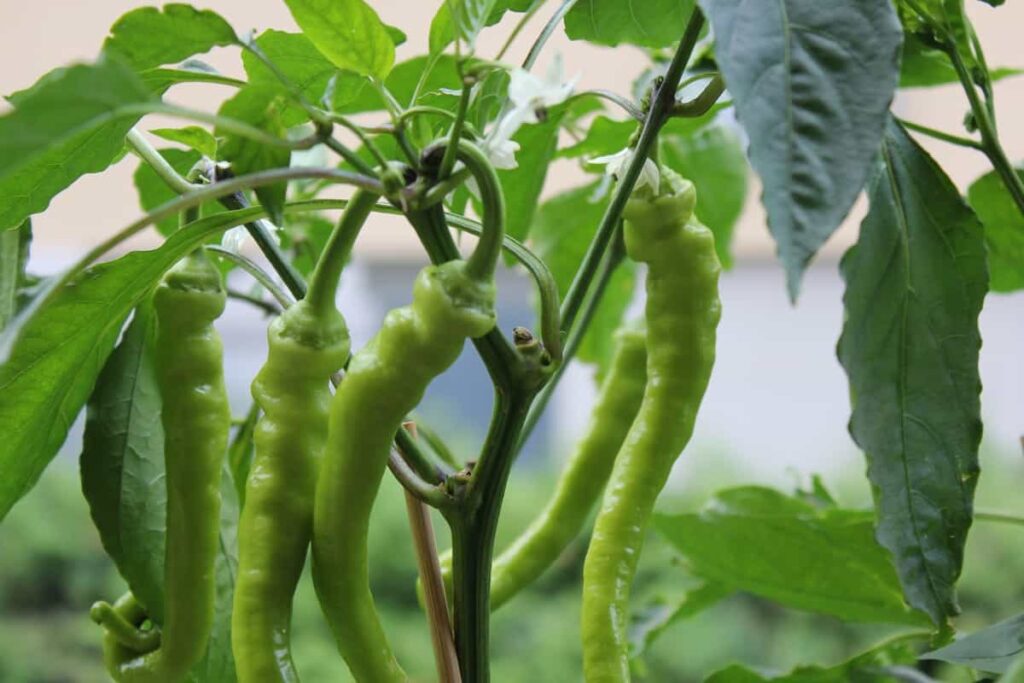
Arka Meghana
The Chilli F1 hybrid was developed using an MS line to produce a high yield. The plants reach a height of 82 cm and spread 69.5 cm. The fruit measures approximately 11 cm in length and 1.2 cm in width. A 50% flowering takes 24 days, which is very early. In 140 to 150 days, it yields 33.5 tons of fresh and 5 tons dry yield per hectare. Its fruits are dark green and turn red when ripe. As well as being highly resistant to powdery mildew, this variety is also resistant to viruses.
Arka Suphal PMR 57
It is an indeterminate plant that grows to 80 to 90 cm. There are pointed tips on the tips of the fruits of this variety, and its foliage is dark green. As the Chillies ripen, the color of the Chilli changes from green to deep red. This variety produces approximately 25 tons of fresh green Chillies or 3 tons of dry Chillies per hectare. As well as being highly resistant to powdery mildew, it is also resistant to viruses in the field.
Arka Sweta
Using an MS line, this high-yielding hybrid Chilli produces a high yield. The plants are medium-sized, about 95 cm high, and 82.5 cm wide. The fruits have a length of 13.2 cm and a width of 1.3 cm. It yields 38.4 tons per hectare fresh and 6 tons per hectare dry in 140 to 150 days. As the fruits ripen, they turn red.
Jwala Sakhi
It evolved from the cross of vellanotchi X Pusa jwala. Sulphury green fruits, long and succulent, yield 19.6 tons of green Chilli per hectare in 125 days. The variety is resistant to leaf spot disease and little leaves.
Jwala Mukhi
It was developed at Kerala Agricultural University, Vellayani, using the same parents as Jwala Sakhi. The fruits are about 9.6 cm long, and the plants are dwarf. The Chillies are dark green and have a mild spice. The variety yields 22.5 tons of green Chilli per hectare in 137 days, tolerant of little leaf and leaf spot diseases.
HPH-490
This variety has excellent potential for producing high yields. The plants can grow straight and tall. The Chillies are long, light green, and compactly arranged. This hybrid variety is one of the earliest hybrids with good disease tolerance.
Gayatri
They have a medium to light green color and a long length. Chillies with compactly arranged seeds have uniform lengths and smooth textures. Besides having a high yield potential, this variety is not very spicy and has medium heat, making it a good choice.
In case you missed it: How to Grow Cherry Tomatoes at Home: from Seeds and Tomatoes in Pots, Indoors, and Planting, Care
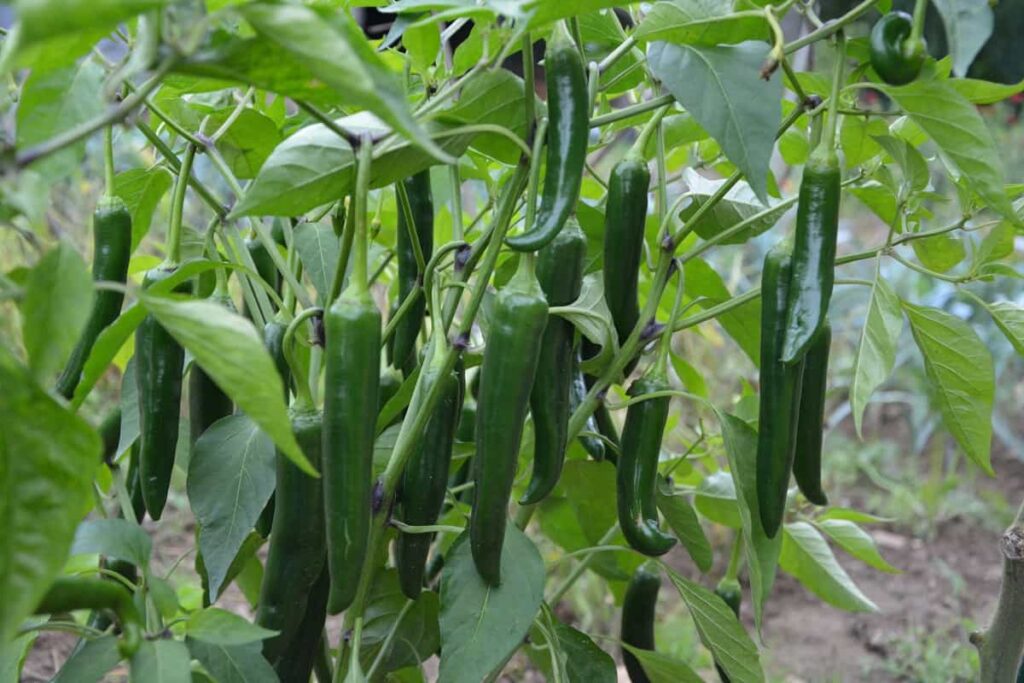
Arka Khyati
With an average length of 10-12 cm, these Chillies are long and smooth in texture. Initially, they are dark green, but when they mature, they turn red. Medium spice and moderate heat characterize Arka Khyatis.
Spicy 2o
This variety has vigorous plants with straight growth that can get bushy. Despite its light green color, the Chillies on this plant are highly intense, moderately hot, and highly fragrant. There is a good market for the variety in the east Indian vegetable markets.
CH-1
It was developed by PAU, Ludhiana. On ripening, the medium-sized light green fruits turn deep red. A high level of spice and attractiveness can be found in the fruits. It is resistant to fruit rot and wet rot. An average yield of 23 tons of red Chillies per hectare can be expected.
CH-3
It was developed at PAU, Ludhiana. Compared to CH-1, fruit length is longer. The content of capsicum is 0.52%. On average, it yields 25 tons of red Chillies per hectare.
HPH-1900
Unlike other Chilli varieties, this variety grows erect and robust. They are light green and have medium to low pungency. This plant produces long Chillies that measure 12 cm in length and 1 to 1.2 cm in diameter. In addition, these trees are heavy bearers; they produce large quantities of Chillies and are moderately spicy. According to season and cultural practices, 25 to 30 tons are produced per hectare in green fresh produce and 3 to 5 tons per hectare in red dry.
Pant C-1: GBPUAT
It is the result of a cross between NP46A and Kandhari. These plants are erect and grow to 50 to 60 cm. In their immature state, the fruits are green, but when they are ripe, they turn red. There are six to seven-cm-long, erect fruits with high intensity. As a result of its upright fruiting pods, this variety is easily distinguished from others. The pods are intense, relatively small in size, broader at the base, and narrow towards the tip. As far as mosaic virus and leaf curl virus is concerned, it is moderately resistant. This variety yields 7.2 tons of green pods per hectare. Approximately 1.5 tons of dry pods are produced per hectare.
HPH-117
Despite its bushy appearance, it is a high-yielding variety. The plants bear Chillis heavily and are semi-prostate. In addition to its small size and light green color, this variety also contains a high percentage of seeds. High heat and strong taste make them highly spicy. Furthermore, the variety is suitable for long-distance transportation. In green fresh, 25 to 30 tons per hectare are produced, and in red dry, 3 to 5 tons per hectare.
K-1
The Chilli is a selection of Assam-type Chillies, also known as B72A. It is a tall and compact plant. The fruits measure 6.6 cm long and contain 0.35 mg of capsaicin per gram. It produces 20 percent more pods than local varieties in a crop period of 215 days, yielding 2 tons per hectare.
K-2
A hybrid derivation of K1 and Sathur Samba is released from TNAU. Plants are compact and tall, with 7.3 cm long fruits containing 0.49 mg of capsaicin per gram. In 210 days, the crop matures, and the fruits are bright red. On average, 1.5 tons of dry pods are produced per hectare.
Kashi Early
The plants are tall (100-110 cm tall) without nodal pigmentation on dull green stems and bear pendant fruits. At physiological maturity, the fruits turn bright red, are long (8-9 x 1.0-1.2 cm), attractive, dark green, and spicy. It takes about 45 days after transplanting to pick the first green fruits. It produces an average yield of 2.45 tons per hectare (red ripe).
In case you missed it: High Yield Hybrid Vegetable Varieties in India: For Winter (Rabi), Summer, and Rainy Season (Kharif)
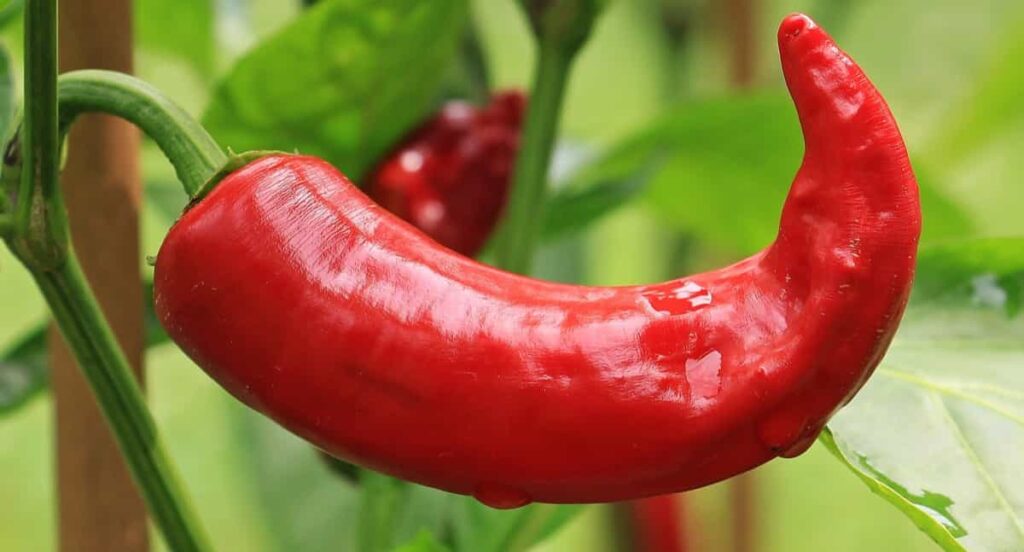
Kashi Surkh
Suitable for producing red and green fruits, the fruits are light green, straight, and 11 to 12 cm long. The plants are semi-determinate (1-1.2 m tall), erect, and have nodal pigmentation on their stems. After 55 days of transplanting, the first harvest occurs, and the green fruit yield is 2.45 tons per hectare.
Harvesting Chilli
Chillies are harvested according to their purpose and at what stage they are grown. There is a large amount of dry Chilli fruit produced by the crop. It takes about a month for the green Chilli crop to be ready for harvesting. Usually, one or two pickings of green fruits are taken, and the product is disposed of in the local market to be used as green salad, vegetable, or condiment. Additionally, this practice enhances the growth of plants and induces them to produce more flowers and fruits, thereby boosting the farmer’s net returns.
The fruits should not be under-ripened or over-ripened when it comes to dry Chillies. The crop is ready for harvest about three and a half months after planting. It usually takes two months to pick all the fruits; six pickings occur a year. When harvesting fruits, it is essential to grasp stalks firmly and gently pull fruit upward, breaking the stalk at the base.
Typically, 2 to 4 pickings are taken from a rainfed crop and 6 to 8 pickings from an irrigated crop. There is an assumption among farmers that frequent picking of irrigated Chillies will cause broken twigs and more labor requirements, so that they will reduce the number of pickings. But, fruits that are harvested late are of poor quality.
Conclusion
Though Chilli is grown in almost all the States of India, it is primarily grown in Andhra Pradesh (46%), Karnataka (15%), Maharashtra, Madhya Pradesh, Orissa, West Bengal, Rajasthan, and Tamil Nadu. Indian Chilli can be grown during the entire year in one or the other part of the country.
The farmer can benefit by cultivating above listed hybrid varieties and getting higher yields. If you live in the following states and plan to start Chilli/Mirchi farming, then this article will help you with different High Yield Hybrid Chilli Varieties in India for Rabi, Kharif, Winter, Summer, and Rainy seasons.
| Andhra Pradesh | Karnataka |
| Arunachal Pradesh | Kerala |
| Assam | Madhya Pradesh |
| Bihar | Maharashtra |
| Chhattisgarh | Manipur |
| Goa | Meghalaya |
| Gujarat | Mizoram |
| Central India | South India |
| Haryana | Sikkim |
| Himachal Pradesh | Tamil Nadu |
| Jharkhand | Telangana |
| Nagaland | Tripura |
| Odisha | Uttar Pradesh |
| Punjab | Uttarakhand |
| Rajasthan | West Bengal |
| North India | West India |
- How to Raise Pigs in Your Own Backyard: A Comprehensive Guide
- Budget Friendly Sheep Shed Ideas: Cheap and Low-Cost Tips
- How Much Do Cattle Farmers Make: Revenue Streams in Cattle Farming
- Management Pests and Diseases in Your Cotton Field
- Sheep Farming Business Plan for Beginners
- Aquaponic Farming at Home: A Step-By-Step Guide
- Profitable Village Farming Business Ideas in 2024
- High-Yield Aquaculture: Fast-Growing Fish for Farming
- Effective Fish Pond Construction Techniques for Beginners
- Irrigation and Water Management in Pineapple Farming
- Blossom to Harvest: Mastering Flowering and Pollination in Papaya Farming
- Pig Fattening Essentials: From Selection to Sale for Beginners
- Raising Wagyu Cattle: A Complete Guide for Premium Beef Production
- Soil Types and Their Water Holding Capacity
- Optimizing Irrigation Schedules for Coconut Groves for Enhanced Yield
- Espresso Your Garden: Coffee Grounds for Healthier Acid-Loving Plants
- The Best Soil Mix for Snake Plants: How to Mix Your Own Snake Plant Soil
- Green Thumb Success: Expert Tips for Cultivating Greenhouse Beans All Year Round
- Bloom All Year Round: The Ultimate Guide to Indoor Hyacinth Care
- Eco-Friendly Gardening: How to Make Liquid Fertilizer from Kitchen Waste
- Ultimate Guide to Grow Anise in Pots: Explore Seed Propagation to Harvesting
- Guide to Raising Chester White Pigs: Discover Breed Facts to Growth Management
- Mastering the Elegance: The Ultimate Guide to Weeping Cherry Tree Care, Planting, and Maintenance
- Ultimate Guide to Planting Garlic in Grow Bags: Growing Strategies for Beginners
- How to Fix Spider Plant Leaf-Related Problems: Natural and Organic Remedies
- 10 Reasons Why Your Tulsi Plant is Shedding Leaves: Home Remedies and Solutions
- Optimizing Growth and Yield: The Advantages of Palm Bunch Ash Fertilizer
- Utilizing Neem Oil Extract as a Natural Pesticide for Hydrangea
- From Soil to Harvest: Various Ways in Which Farmers Can Use AI Tools
- Steps to Encourage and Induce Citrus Flowers: A Comprehensive Guide
- How to Fix Snake Plant Leaf-Related Issues: Natural and Organic Remedies
- Transform Your Garden into a Fragrant Oasis with Raat Ki Rani (Night Blooming Jasmine)
- Discover the Ideal Chicken Breeds for Philippine Farms
- How to Create a Poultry Egg Farm Business Plan for Profits
- Grow Lemon Cucumbers Like a Pro: Insider Techniques for Bountiful Yields
- Ultimate Guide to Caring for Your Pink Princess Philodendron: Tips for Thriving Variegation

Pl also give availability of seeds
Good job.